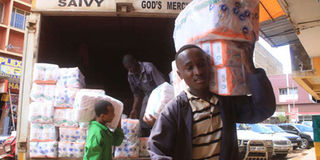Country facing food balancing equation as prices of basics rise

Bags of subsidized maize flour being taken to Samrat supermarket in Nyeri Town on May 17, 2017. The price of the staple food is likely to be much higher than the current subsidised price. PHOTO | JOSEPH KANYI | NATION MEDIA GROUP
What you need to know:
- Kenya imports the majority of the wheat it requires and a significant amount of maize.
- The government, farmers, millers, wholesalers and retailers must work in tandem.
Kenyans have had a year of mixed fortunes in obtaining adequate affordable food.
The dearth of rainfall and drought have pushed up the prices of many basics, food especially.
The food equation is likely to remain precarious and challenging certainly for the rest of the year and this is likely to spill over into next year.
RAINFALL
Several factors, such as whether the forthcoming rains will be sufficient, will decide how long our difficulties will continue.
Kenya imports the majority of the wheat it requires and a significant amount of maize, especially when rainfall has been poor.
The figures on the latter tend to get a little fudged because of informal maize imports from Tanzania and Uganda when they have surpluses.
So what exactly is the current scenario?
As things stand, Kenya has enough maize for the time being.
MAIZE
This is a result of two factors: Considerable government instigated imports and the harvesting of the maize crop in the surplus growing regions of Trans Nzoia and Uasin Gishu, which is now cranking in.
Although that crop will be below average, the combination is likely to ensure Kenya has enough maize for about six months.
The complications and controversy will be regarding pricing, especially as the subsidy programme is phased out.
Whichever way one looks at it, the price is going up.
SUBSIDY
The challenge in the coming months, therefore, will be the price.
The government has spent Sh6 billion on subsidising the price, and extending this ad infinitum is not a financially sustainable option.
At the same time, farmers are pushing for in excess of Sh3,000 per bag, especially as they argue the cost of inputs has risen.
The market equilibrium is such that National Cereals and Produce Board would have to move in that direction to restore its strategic reserve.
TRADE
The dilemma for the cereals board is that if it does not offer a reasonable price, farmers will sell directly to the private sector.
The likely scenario after the end of the subsidised programme is that the price of a 2kg packet of maize could rise by as much as 50 per cent.
This is the painful flip side of subsidies. The next challenge will be where to get maize from in the second quarter of next year when Kenya will be between harvests.
Will Tanzania and Uganda have surpluses to export to Kenya?
As things stand, Tanzania has banned the export of maize.
IMPORT
Even more relevant is that the chances of either country having adequate surplus crops are not looking great.
Zambia has a surplus but would disagreements over transporting maize by road via Tanzania make this difficult?
If these two options do not make up the gap, then Kenya will need to import from other countries outside of Comesa, and would also need to consider the relevant duty waiver so the maize is sold at an affordable price.
Again, whichever option or combination of options one looks at, the price of the staple food is likely to be much higher than the current subsidised price.
SOLUTION
As important is to learn some lessons from what has happened in the past few months.
The first and foremost is for the government to be more proactive when shortfalls loom.
There is more than enough work being done to project and forecast the size of crops and where and when the shortfalls will occur.
The government needs to act faster. Hiccups in supply result in upward price fluctuations.
INCLUSION
Coupled with this should be a recognised formula to fall back on.
When shortfalls are projected the country kicks into a mode and formula allowing imports.
The government needs to move away from micro managing such processes complete with the usual risk of mismanagement and corruption.
The government is one of several players in this process and equation and, must foster a more inclusive approach and participation.
The government, farmers, millers, wholesalers and retailers must work in tandem.
This is not an “us” and “them” situation.
Mr Shaw is a public policy and economic analyst: [email protected]





